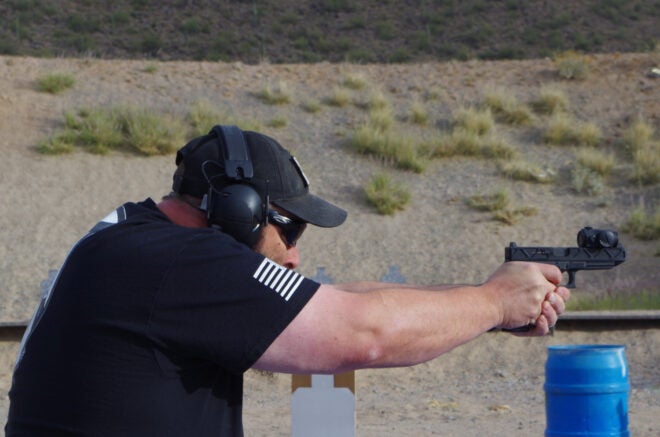We understand the importance of protecting your hearing in various environments, whether at the range or on the hunt, at work, during recreational activities, or even for everyday noise reduction. In this comprehensive buyer’s guide, we will explore and compare different products available in the market to help you choose the best over-the-ear hearing protection that suits your needs and will help you navigate the top over-the-ear hearing protection products on the market, focusing on key factors like comfort, noise reduction rating (NRR), durability, and design.
2023 Fall Buyer’s Guide: Over-the-Ear Hearing Protection
Factors to Consider
Before diving into the product comparisons, let’s look at the key factors to consider when choosing over-the-ear hearing protection:
Noise Reduction Rating (NRR)
The NRR indicates the noise reduction the hearing protection device provides. Higher NRR values signify greater noise reduction capabilities.
The Noise Reduction Rating (NRR) is a standard measurement used in the United States to determine the effectiveness of hearing protection devices in reducing exposure to dangerous noise levels. It’s a crucial factor to consider when choosing hearing protection as it represents the maximum reduction in volume that the device can provide.
NRR is measured in decibels (dB), and a higher NRR signifies better noise reduction. For example, a device with an NRR of 30 will reduce the environmental noise level by approximately 30 dB. This doesn’t mean complete silence but significantly reduced harmful noise exposure.
However, it’s important to note that NRR doesn’t account for user error or improper fit, which can significantly decrease the hearing protector’s performance. For instance, if an earmuff isn’t sealing properly over your ears, it won’t provide the full NRR.
Also, while a higher NRR generally means more noise reduction, it doesn’t necessarily mean it’s the right choice for every situation. In some environments, over-protection can also be risky, for example, if you cannot hear important signals or communication. Therefore, selecting a hearing protection device with an appropriate NRR for your particular needs and environment is essential.
In conclusion, NRR is a key factor in selecting hearing protection devices. Still, it should be considered along with other factors such as comfort, fit, and the specific noise levels and frequencies you’ll be exposed to.
Comfort

Consider the comfort level the earmuffs offer, including cushioning materials, adjustable headbands, and overall ergonomic design. Prolonged use should not cause discomfort or fatigue.
Comfort is a critical factor to consider when choosing over-the-ear hearing protection devices, particularly for those who will be wearing them for extended periods. Here are some key elements that contribute to the comfort of these devices:
- Cushioning: The cushioning material used in the ear cups plays a significant role in the comfort level of the hearing protection device. High-quality cushioning can provide a snug fit without causing discomfort. Some materials also offer better noise isolation than others. Look for soft, durable materials that conform to the shape of your ears without applying too much pressure.
- Adjustable Headbands: An adjustable headband allows you to customize the fit of the earmuffs to your head size and shape. This can significantly enhance comfort, especially during prolonged use. Some headbands also come with padding for additional comfort.
- Weight: The weight of the hearing protection device can impact comfort. Heavier models may cause fatigue or discomfort over time. Lightweight models are generally more comfortable for extended wear.
- Breathability: Good breathability can prevent your ears from becoming hot and sweaty. This is particularly important in warm environments or during physical activity. Look for materials that allow for good air circulation.
- Ergonomic Design: Ergonomically designed earmuffs take into account the natural shape and curves of the human ear and head, providing a more comfortable and secure fit. Some models also feature tilt and swivel functions for further customization.
- Pressure Distribution: How the pressure is distributed around your ears can affect comfort. Even pressure distribution helps avoid discomfort or pain after prolonged use.
Remember, comfort varies from person to person, so what works best for one person might not work well for another. It’s always a good idea to try on different models before deciding on the most comfortable hearing protection for your needs.
Durability

Photo by Moritz Mentges on Unsplash
Look for products made from high-quality materials that can withstand frequent use and potential rough handling. Durable earmuffs ensure long-lasting protection.
Durability is a vital consideration when choosing over-the-ear hearing protection devices. A durable device will provide consistent performance and offer better value for money by lasting longer. Here’s what to look for:
- Material Quality: The materials used to construct the earmuffs can significantly impact their durability. Look for high-quality, robust materials like ABS plastic that can withstand impacts and resist wear and tear. The cushioning material should also be durable and resistant to deformation over time.
- Build Quality: The overall build quality of the earmuffs is another important factor. This includes the quality of the stitching, the hinges (if any), and the headband. A well-built product will have no loose or wobbly parts and feel solid and sturdy.
- Water and Dust Resistance: If you use earmuffs in outdoor environments, look for water- and dust-resistant models. This will protect the electronic components and increase the overall lifespan of the device.
- Cord Quality (if applicable): If the device includes a cord for audio input, check the quality of the cord and its connection points. A good-quality cord is thick, flexible, and securely attached to the earmuffs.
- Battery Life (for electronic models): For electronic hearing protection devices, the battery life can indicate the overall quality and durability of the electronics. Longer battery life usually means better design and higher quality components.
- Brand Reputation: Brands with a reputation for quality and durability are often a safe bet. They’re more likely to use high-quality materials and manufacturing processes, ensuring a durable end product.
Remember, while durable products may cost more upfront, they can save money in the long run by reducing the need for replacements. Always consider durability and other factors like comfort, noise reduction, and price to find the best hearing protection.
Design
You should choose a design that suits your preferences and intended use. Whether you prefer sleek and compact earmuffs or robust and heavy-duty options, various designs are available to match your style and requirements.
Design is a key aspect to consider when choosing over-the-ear hearing protection devices. It can affect the aesthetics, functionality, and comfort of the earmuffs. Here’s what you should think about:
- Size and Shape: Earmuffs come in various sizes and shapes. Compact designs are usually lightweight and easy to carry, making them ideal for travel or occasional use. On the other hand, larger, robust designs often offer superior noise reduction and are suitable for heavy-duty applications like construction work or shooting ranges.
- Color and Style: Earmuffs are available in various colors and styles. Some people prefer a sleek, modern look with neutral colors, while others want something more vibrant or distinctive. The style should align with your personal preferences and work uniform or dress code (if applicable). You probably should think twice about showing up on the flight line before launching on Operation Neptune Spear with ear pro rocking built-in kitty ears.
- Foldable Design: Some earmuffs come with a foldable design, which can be handy for storage and portability. This feature especially benefits those who travel frequently or must carry their hearing protection in a bag or kit.
- Electronic vs. Passive: Electronic earmuffs incorporate technology to amplify safe sounds (like conversations) while blocking harmful noise levels. They are typically used in environments where communication is crucial, such as shooting ranges or construction sites. On the other hand, passive earmuffs simply reduce all noise and are usually less expensive.
- Additional Features: Some earmuffs have extra features like built-in radios, Bluetooth connectivity, or audio input jacks. These can be useful for listening to music or staying connected while protecting your ears. Plus, the microphone and audio inputs make your LARPing sesh with your mates look all that more realistic.
- Maintenance: The design should also make the earmuffs easy to clean and maintain. Removable and washable ear cushions, for example, can help keep the earmuffs hygienic over time.
Remember, the best design for you will depend on your specific needs and preferences. Always consider how you’ll use the earmuffs, in what environments, and for how long.
Compatibility
If you plan to use other safety equipment, such as helmets or eyewear, ensure that your chosen over-the-ear hearing protection is compatible and can be comfortably worn together.
Compatibility with other safety equipment is a crucial aspect to consider when choosing over-the-ear hearing protection. You must ensure that your earmuffs can be comfortably and effectively worn with other protective gear. Here’s what to look out for:
- Helmet Compatibility: If you frequently wear a helmet (for construction work, motorcycle riding, or other activities), it’s important to choose earmuffs that fit comfortably underneath or attach to the helmet. Some earmuffs are specifically designed for this purpose, with slim profiles and attachment points for hard hats.
- Eyewear Compatibility: Glasses and goggles can interfere with the seal of the earmuffs against your head, reducing their effectiveness. Look for hearing protection devices designed to work well with eyewear. These often feature cut-outs or softer padding where the glasses’ arms rest.
- Other PPE Compatibility: If you wear other personal protective equipment (PPE) like respirators, face shields, or neck protectors, make sure your earmuffs won’t interfere with these items and vice versa.
- Comfort: Even if the earmuffs are compatible with your other gear, they must be comfortable (see the previous section). Wearing multiple pieces of equipment at once can be bulky or restrictive, so it’s important to choose earmuffs that won’t add unnecessary discomfort.
- Ease of Use: The earmuffs should be easy to put on and remove, even when wearing other protective equipment. They shouldn’t require excessive adjustment each time they’re worn.
Safety is paramount; all your protective equipment should work together seamlessly to provide maximum protection. Always check the compatibility of your earmuffs with the rest of your safety gear before making a purchase.
Now that we have outlined the key considerations, let’s delve into the comparison of popular over-the-ear hearing protection options available in the market.
Products
None of the products we compared were uncomfortable. They all met our requirements for comfortable wearing over several hours. Note that on a hot day, you will still get “swamp ear,” so take frequent breaks and get some air on your head.
1. Walker’s Razor Slim Electronic Ear Protection
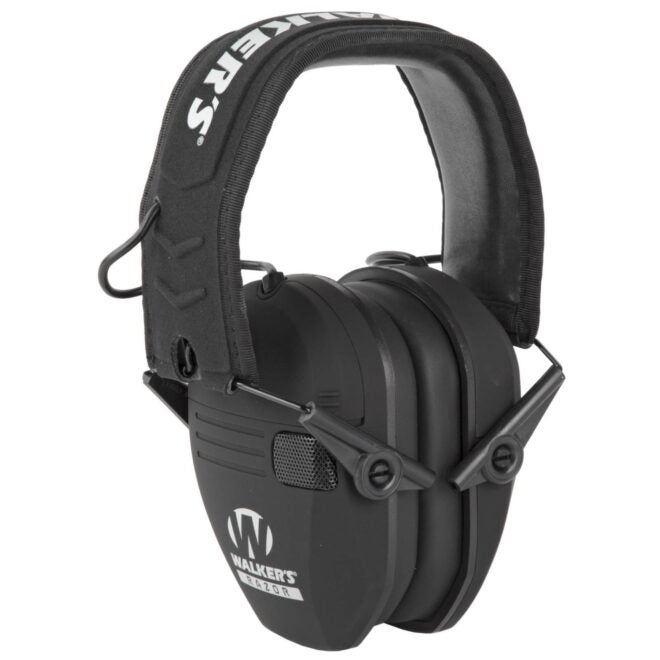
The Walkers Razor 23NRR Slim Folding Electronic Earmuff Black is an excellent choice for those who enjoy outdoor activities like hunting and shooting. Its advanced electronic design amplifies sound up to eight times the normal level, enhancing your auditory experience. Its sleek design ensures a comfortable fit, while its foldable nature makes it convenient for storage. It also comes in FDE for those of you who love the desert.
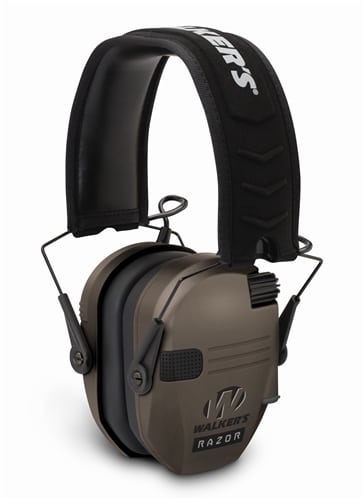
FDE version
Boasting a noise reduction rating of 23 decibels, these earmuffs shield your ears from potentially damaging loud noises. They also have an auto shut-off feature that turns off the sound amplification after four continuous hours of use, conserving battery life.
The Walker’s Razor earmuff is designed with user comfort in mind, featuring an adjustable headband for a snug fit. It also offers two listening modes: the standard mode for everyday listening and the Boost mode for enhanced sound amplification in noisy environments like shooting ranges.
The earmuffs include a handy carrying case for easy transportation, making the Walkers Razor a perfect travel companion. Powered by two AAA batteries (not included), it offers up to 350 hours of operation on a single set of batteries. Whether you’re hunting or shooting, this slim and foldable earmuff is designed to offer optimal safety, comfort, and ear protection.
2. Walker’s Bluetooth Razor Slim Electronic Ear Protection
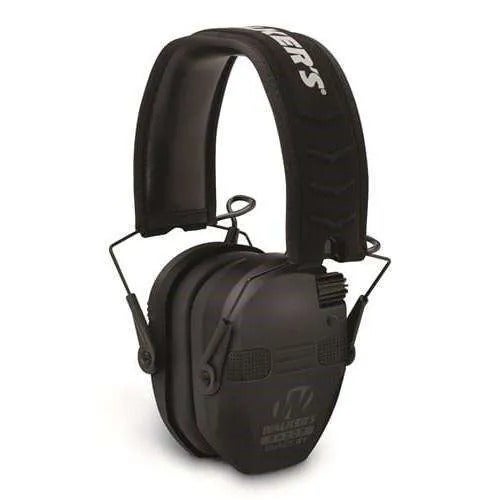
The Walker’s Bluetooth Razor Slim Electronic Ear Protection provides the same reliable noise reduction as the standard model, with the added bonus of Bluetooth connectivity. This feature lets you connect your device for music or calls without compromising hearing protection. They maintain a slim design for mobility and comfort, making them an excellent choice for those who need entertainment while ensuring their ear protection. Feel free to jam out to your favorite Nickleback tune while doing Dot Torture.
3. Howard Leight Impact Sport Electronic Ear Protection
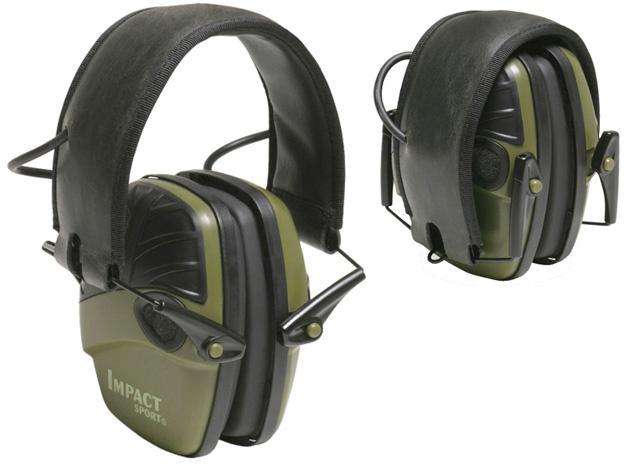
The Howard Leight Impact Sport Electronic Ear Protection is known for its effective noise cancellation and sound amplification features. With an NRR of 22dB, these earmuffs provide excellent noise reduction while allowing for ambient sounds to be heard clearly. The earmuffs are comfortable for extended wear and are praised for their ability to provide clear communication in noisy environments.
The Impact Sport Sound Amplification Electronic Earmuff provides an optimum balance of safety and ear protection. It enhances low-level sounds like conversation and range commands up to a safe 82 dB while blocking out any noise exceeding this level.
Designed for both range and field use, the earmuff features unobtrusive earcups, with a cutout, that doesn’t interfere with aiming. The padded, telescopic headband ensures a comfortable fit tailored to your needs. For convenience, the earmuff folds into a compact size for easy storage on the range or in the field. The earmuff also features snap-in ear cushions for easy replacement and extended performance.
Furthermore, it comes with an external audio jack, which allows it to double as stereo headphones when connected to an MP3 player or another audio source. Also, who actually still has an MP3 player? As a low-energy device, the earmuff automatically shuts off after 4 hours and comes with a snap-on lid for easy battery replacement. It includes two AAA batteries to get you started.
4. Peltor Sport Tac 500 Bluetooth Electronic Ear Protection
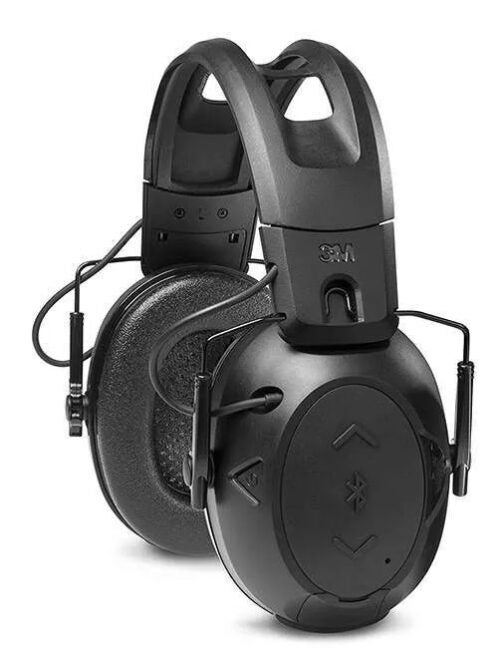
The Peltor Sport Tactical Electronic Hearing Protector earmuffs are designed with low-profile cups for use with rifles or shotguns. They leverage 3M’s proprietary SMART technologies to suppress gunshot noise and amplify quieter sounds, and they also include an auto shut-off feature. The earmuffs’ Gunshot Recognition and Suppression Technology tailors noise protection based on the specific firearm and environment, while their Clear Voice Tracking Technology enhances speech intelligibility and situational awareness by isolating voices from background noise.
These earmuffs are designed for optimal comfort and fit. The ventilated, adjustable headband increases comfort when worn with hats. The low-profile cups feature cut-outs for use with long guns, and intuitive buttons and voice guidance allow for easy operation without needing to remove the headset. The durable, recessed microphones are engineered to reduce wind and fan noise. The comfortable cushions ensure a snug fit for long periods of use.
The Sport Tactical 500 model boasts a targeted NRR of 26 dBA for passive sound protection. It also incorporates Bluetooth wireless technology, syncing with mobile devices and enabling you to make and receive phone calls directly through the headset.
5. Walkers XCEL 500 Bluetooth Electronic Ear Protection
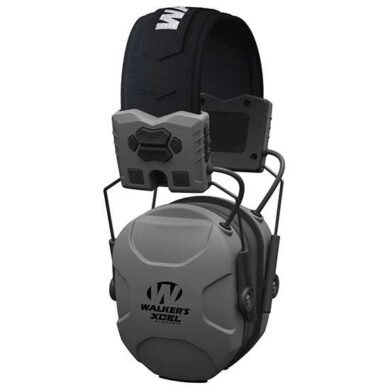
The Walkers XCEL 500 Bluetooth Electronic Ear Protection earmuffs have a relatively high NRR of 26dB, offering excellent noise reduction capabilities. The Bluetooth connectivity adds the convenience of wireless music streaming or call handling. The design includes an ergonomic headband and ear cushions for maximum comfort during extended wear.
What sets the Walkers XCEL 500bt apart is the innovative, patent-pending design that relocates the digital control panel and microphones from the muff cup to the headband. This change allows for increased air space inside the cup, enhancing the overall protection quality.
These earmuffs are equipped with a state-of-the-art digital circuit, dynamic sound suppression, high-gain omnidirectional microphones, and four distinct listening modes: universal, speech clarity, high frequency, and power boost. These features make the Walkers XCEL 500bt earmuffs an excellent choice for advanced hearing protection and enhancement.
Comparison Matrix
To help you compare the different over-the-ear hearing protection options, we have created a matrix based on key features and user ratings.
The reality is that we didn’t pick any ear pro that was uncomfortable. Most ear protection today is designed for extended wear, not counting the budget junk you might find on Alibaba. Most of you will not continuously wear ear protection for more than a couple of hours if even that.
All of these units also exhibit high durability. They are made with decent materials, designed to withstand the normal conditions on a range. They also have auto shutoff features to conserve battery life, which is helpful if you forget to turn them off after a long day on the range.
|
Product |
Comfort |
NRR |
Bluetooth |
Design |
|
High |
23dB |
No |
Slim, low-profile |
|
|
High |
23dB |
Yes |
Slim, low-profile with Bluetooth |
|
|
High |
22dB |
No |
Low-profile |
|
|
High |
26dB |
Yes |
Adjustable headband with Bluetooth |
|
|
High |
26dB |
Yes |
Ergonomic headband with Bluetooth |
Remember, the best over-the-ear hearing protection for you depends on your specific needs and preferences. Consider the most important factors to you, such as comfort, noise reduction rating, durability, design, and price, before purchasing.
Conclusion
Choosing the right over-the-ear hearing protection involves carefully considering several key factors. You need to consider the level of noise reduction you need, the comfort and fit of the earmuffs, their durability, and how well they align with your personal style.
If you wear other safety gear, it’s crucial to ensure your earmuffs are compatible and can be comfortably worn with this equipment. No matter what your specific needs or preferences are, there’s a pair of earmuffs out there that’s perfect for you.
With this guide, you can decide and choose the hearing protection that will best serve you in your work or leisure activities. Remember, your hearing is invaluable – invest in its protection wisely.
 Your Privacy Choices
Your Privacy Choices
